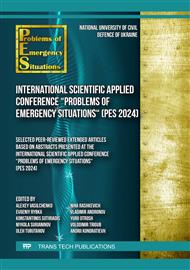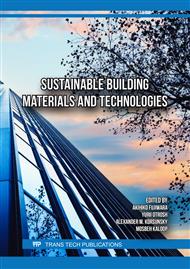[1]
Guzii S.G., Investigation of the influence of organo-mineral modifiers on the physical and rheological properties of aluminosilicate adhesives for wood bonding. Bulletin of Odessa State Academy of Civil Engineering and Architecture. 79 (2020) 70–77.
DOI: 10.31650/2415-377x-2020-79-70-77
Google Scholar
[2]
S. Guzii, Features of production and application of glued wooden beams in cottage construction. IOP Conf. Ser.: Mater. Sci. Eng. 1164 (2021) 012028.
DOI: 10.1088/1757-899x/1164/1/012028
Google Scholar
[3]
G. Lin, Y. Zheng, et al., Improving the performance of geopolymer-based wood adhesives using a green mechanochemical strategy. International Journal of Adhesion and Adhesives. 129 (2024) 103558.
DOI: 10.1016/j.ijadhadh.2023.103558
Google Scholar
[4]
Liu, Xiaomei et al. PVA wood adhesive modified with sodium silicate cross-linked copolymer. Proceedings of 2012 International Conference on Biobase Material Science and Engineering. (2012) 108-111.
DOI: 10.1109/bmse.2012.6466192
Google Scholar
[5]
W. Yu, W. Lu, X. Han, H. Cai, Aluminum silicate fibers reinforced wood-plastic composites: A strengthening strategy based on the interfacial interactions between inorganic fibers and organic agricultural wastes. BioResources. 16(2) (2021) 3678–3690.
DOI: 10.15376/biores.16.2.3678-3690
Google Scholar
[6]
Marko Petrič, M. Chapter 2. Influence of Silicon-Containing Compounds on Adhesives for and Adhesion to Wood and Lignocellulosic Materials: A Critical Review. Book Editor(s): K.L. Mittal, (2019).
DOI: 10.1002/9781119625322.ch2
Google Scholar
[7]
B.S., Mamatha, et al., Properties of flyash based wood geopolymer composite. Low-carbon Materials and Green Construction. 1 29 (2023).
DOI: 10.1007/s44242-023-00030-6
Google Scholar
[8]
S.G. Guzii, Study of the biostability of aluminosilicate adhesives for bonding wood. Bulletin of the Odesa State Academy of Civil Engineering and Architecture. 77 (2019) 126–134.
Google Scholar
[9]
S.G. Guzii, Determination of the calculated values of strength and stiffness of glued wooden beams during a fire. Resource-saving materials, structures, buildings and structures: scientific and technical collection (NUEE). 39 (2021) 63–73.
Google Scholar
[10]
S. Guzii, et al., Investigation of the Rheokinetic Properties and Penetration Depth of Aluminosilicate Adhesive in Pine Wood. Solid State Phenomena. 321 (2021) 97–103.
DOI: 10.4028/www.scientific.net/ssp.321.97
Google Scholar
[11]
P. Krivenko, et al., Alkaline aluminosilicate binder-based adhesives with increased fire resistance for structural timber elements. Key Engineering Materials. 808 (2019) 172–176.
DOI: 10.4028/www.scientific.net/kem.808.172
Google Scholar
[12]
P. Krivenko, et al., Study on physico-mechanical properties of the modified alkaline aluminosilicate adhesive-bonded timber elements. Solid State Phenomena. 296 (2019) 112–117.
DOI: 10.4028/www.scientific.net/ssp.296.112
Google Scholar
[13]
P.V. Krivenko, S.G. Guziy, Study of the ratio of oxides in the composition of alkaline aluminosilicate binder on its elastic modulus. Bulletin of the Odesa State Academy of Civil Engineering and Architecture. 73 (2018) 64–72.
Google Scholar
[14]
F. Kollman, Einflub der Vergeschichte des Holses auf seine Verleimung. Holstechnologie. Sonderhegst. (1964) 27–37.
Google Scholar
[15]
S.G. Guziy, et al., Investigation of the stage of phase transitions of the binder system of the composition Na2O×Al2O3×6SiO2×20H2O in the temperature range 150–1050 °C. Building materials, products and sanitary equipment. 49 (2013) 13–20.
Google Scholar



